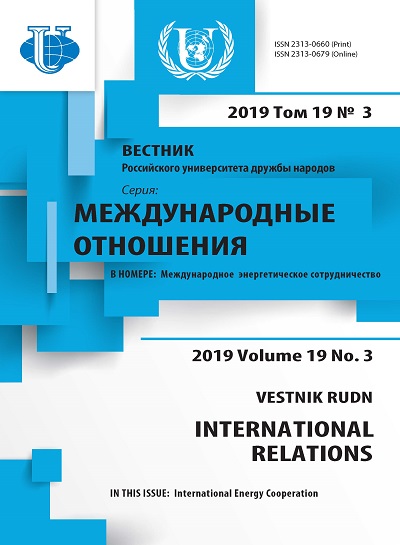International Dimension of Contemporary U.S. Energy Policy: Challenges for Russia and the World
- Authors: Borovsky Y.V.1
-
Affiliations:
- Moscow State Institute of International Relations (University) of the Ministry of Foreign Affairs of the Russian Federation
- Issue: Vol 19, No 3 (2019): International Energy Cooperation
- Pages: 341-353
- Section: THEMATIC DOSSIER
- URL: https://journals.rudn.ru/international-relations/article/view/22585
- DOI: https://doi.org/10.22363/2313-0660-2019-19-3-341-353
- ID: 22585
Cite item
Full Text
Abstract
Since the mid-2000s, the American energy industry has undergone profound changes. Having made the so-called shale revolution and achieved impressive results in the field of energy efficiency and renewable energy, the United States of America has not only radically reduced its dependence on imported hydrocarbons, but has begun to increase exports of these commodities. Given the economic weight of the U.S., such changes have significantly transformed the global energy market, requiring leading oil and gas exporters (including Russia) to take non-standard steps (for example, the OPEC+ deal). They also created serious prerequisites for Washington’s revision of its traditional energy policy in the international arena. The author makes a conclusion that the United States has not yet come out of the paradigm of net oil importer, which was formed after the first world oil crisis of 1973-1974. This means that Washington is still committed to the traditional principles of it’s foreign energy policy: diversification of oil import sources; promotion of free trade in world energy; special relations with oil exporters in the Persian Gulf and the strategic importance of the Middle East; reliance on energy suppliers from the Western hemisphere, etc. However, having radically reduced oil and gas imports and having got the opportunity to export them, the United States could not help but bring something new to its energy policy. While still prioritizing security of energy supply, the U.S. under B. Obama has started talking about the American energy independence, and D. Trump has proclaimed the global energy dominance as a new key American goal. The author assumes that global energy dominance implies Washington’s aggressive promotion of the American energy exporters, as well as its intention to turn the U.S. into a technological leader and a key regulator in the global energy market. Moreover, the U.S. has become freer in the matter of sanctions and other pressure on major oil and gas exporters, guided by its geopolitical and economic interests. Due to the growth of the American oil and gas export potential, the confrontation between Moscow and Washington in the energy sector, which began during the Cold war, has now acquired an additional economic dimension. Previously, the United States has tried to restrain the development of the Soviet, later Russian energy industry, but acted purely in the logic of political rivalry, not economic competition. Thus, in the foreseeable future the United States is unlikely to abandon its attempts to politicize and discredit Russia as an energy supplier to Europe and other regions of the world.
Keywords
About the authors
Yury Viktorovich Borovsky
Moscow State Institute of International Relations (University) of the Ministry of Foreign Affairs of the Russian Federation
Author for correspondence.
Email: yuribor@mail.ru
PhD in History, Associate Professor, the Department of International Relations and Foreign Policy of Russia
Moscow, Russian FederationReferences
- Arbatov, A.G. (2016). Nuclear Agreement with Iran: Phenomenon or Precedent? World Economy and International Relations, 3, 5—15. (In Russian).
- Biryukova, N.A. (2017). From ‘Independence’ to ‘Dominance’: A Comparative Analysis of the Obama and Trump Administrations’ Energy Policy. Moscow State University Bulletin. Series 25: International Relations and World Politics, 4, 144—176. (In Russian).
- Borovsky, Y.V. (2011). Contemporary Problems of the World Energy Industry. Moscow: Navona. (In Russian).
- Borovsky, Y.V. (2018b). Hurdles Hampering Russia’s Oil and Natural Gas Exports: Competition or Rivalry. Bulletin of the Diplomatic Academy of the Ministry of Foreign Affairs of Russia. Russia and the World, 2, 148—158. (In Russian).
- Borovsky, Y.V. (2018a). International Rivalry: Theoretical and Linguistic Aspects. International Relations, 3, 65—72. (In Russian).
- Bronson, R. (2008). Thicker Than Oil: America’s Uneasy Partnership with Saudi Arabia. Oxford University Press.
- Diehl, P. & Goertz, G. (2001). War and Peace in International Rivalry. Ann Arbor: University of Michigan Press.
- Korneev, A.V. (2016). New Trends in the Development of U.S. Energy Industry. USA and Canada: Economy, Politics and Culture, 3, 35—56. (In Russian).
- Ladislaw, S. (2018). Geopolitics of U.S. Oil and Gas Competitiveness: Statement before the House Foreign Affairs Subcommittee on Terrorism, nonproliferation, and Trade. May 22. URL: https://docs.house.gov/meetings/FA/FA18/ 20180522/108347/HHRG-115-FA18-Wstate-LadislawS-20180522.pdf (accessed: 10.01.2019).
- Sidorova, E. (2016). Russian Energy Industry under the Western sanctions. International trends, 1, 143—155. (In Russian).
- Wallin, M. (2018). U.S. Military Bases and Facilities in the Middle East. Washington: American Security Project. URL:
- https://www.americansecurityproject.org/wp-content/uploads/2018/06/Ref-0213-US-Military-Bases-and-FacilitiesMiddle-East.pdf (accessed: 10.01.2019).
- Yergin, D. (2018). The Prize: The Epic Quest for Oil, Money, and Power. Moscow: Alpina Publisher. (In Russian).
- Zakharov, P.V. (2015) The United States’ Current Energy Policy. Problems of National Strategy, 4, 180—200. (In Russian).
- Zenko, M. (2018). US Military Policy in the Middle East. An Appraisal (Research paper). US and Americas Programme, October.
Supplementary files










